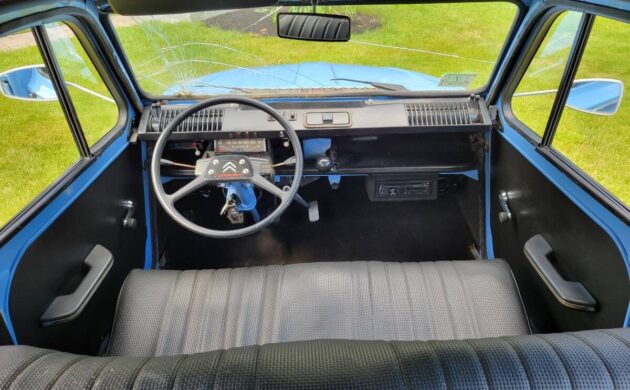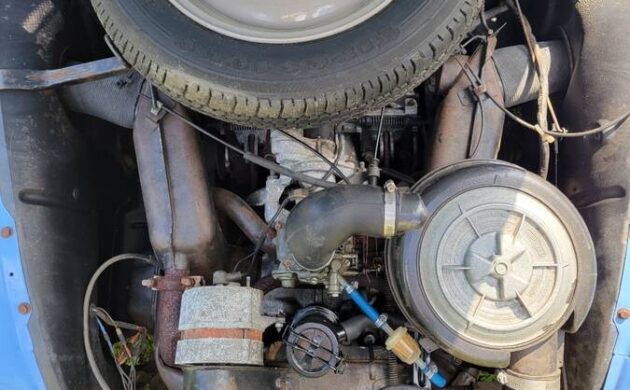Citroen’s 2CV (or deux chevaux – two horses) was born in the mid 1930s. The company’s chief engineer, Pierre-Jules Boulanger, reportedly aimed to ease the course of farmers from field to market by supplying a cheaper, faster conveyance than the horse. Conceived as a two-seater with an aluminum body and well-sprung so as to carry eggs across rutted roads without breakage, the car also needed to start readily and load easily. Development was slow. Citroen had been ushered into the arms of Michelin by bankruptcy, whereupon Monsieur Michelin commandeered the direction of the suspension to coordinate with its tires, which were also under development. Then Michelin was killed in a car accident. Finally, by 1939 about 250 prototypes had accumulated, and the car was set for its public introduction at the Paris Motor Show that fall. Adolf Hitler’s invasion of Poland in September threw the world into war, and the little deux chevaux was once again shelved for matters of greater gravity. When it finally emerged in 1949, it was an instant success. The basic design evolved slowly until the four-seat Dyane was launched in 1967, followed about ten years later by the Acadiane van. Here on craigslist is a 1984 Citroen Acadiane van with an asking price of $8900, located in Rockland, Massachusetts. (Note that the car may not be legal to register in California, so if you live there and have a yen for a late model 2CV, be sure to consult DMV.) We have Mitchell G. to thank for this rare tip!
We’ll dispense the bad news up front: This van was the victim of a falling tree branch that cracked its windshield, put a nasty dent in its cowl, and sprung its hood. A shame, because the rest of the vehicle is quite nice. The trim is clean and bright, the rear panels are straight, the paint is fine. (Note here the wiper blades are missing.)
The interior gives us nothing to complain about, though it is the epitome of spartan. The cargo area is – if not capacious – at least clean. An alternative layout called the Mixte had a rear bench seat and sliding rear windows. Note our subject vehicle has the optional driver-side sun visor.
The engine is an air-cooled 602 cc flat-two with about 36 hp, good enough for highway speeds. A four-speed manual gearbox – with top gear equivalent to overdrive – puts the power to the front wheels. The Acadiane followed Citroen’s first 2CV van, called the Fourgonnette, introduced in 1950. For tax purposes, the Fourgonnette was rated at 2 hp (having a 375 cc flat-two) while the Acadiane was rated at 3, thereby not technically a “deux” chevaux any longer. By convention, the 602 cars are referred to as “2CV 6’s”. Though more than 250,000 Acadianes were made, the model remains rare on our shores. This one was remade into a coffee kiosk, and others have been made into campers. Values are not high; this price might be on the rich side given the work required.






Yeah start high and leave room to bargain but this is crazy.
It is a big ask for one of these. Especially one which lost a fight with a tree.
Not really. Checked Hemmings.com and 2CVs go for $20-33,000. This one is a bargain, especially if you do your own repairs.
It seems normal these days when cars are skyrocketing in value and prices people will pay, that a seller might ask for a supposedly “crazy” price because there is NO WAY to determine the real value. Certainly reading posts on internet groups will get you know definitive answer.
‘optional driver-side sun visor’. Back to the good old days when heaters, carpets, mirrors & radios were at additional cost. No wonder that Japanese cars hoovered up the competition in Europe.
And painted French Blue, oddly enough (lol). In the early ‘60’s round Madrid (Spain)you’d see these lined up in the parking area for the farmers who’d brought their goods to the daily farmers market. “Dos Caballos” were as thick as the SEAT sedans in any big city then, but our housekeepers fiancée had a ‘53 Buick Roadmaster taxi that dwarfed even some of the commercial trucks!
When we left, we sold him our ‘57 Chevy 210 for $30, a month’s work for him..
I live in Madrid. You still see these around. Not so many ’53 Buick Roadmasters, so if I see one, I’ll know it was yours.
Or a white 2 door ‘57 Chevy 210 with 3 on the tree and a 265(283?)V8!
Extremely well written presentation from the author….👏👏🚗
Thanks! One of the parts of the story I didn’t have space for was how the 2CV was hidden from Nazi’s during the advent of the war. They were buried, taken apart, altered, etc to keep the “technology” away from the enemy. All the same, apparently the Nazi’s laid hands on the drawings and machinery for making the 2CV, but the French did their level best to disguise the intent of those items so it wasn’t clearly pointing to a car. I wish I could find out more about all that….
I have read that Citroen through the war developed the chassis and running gear at the Michelin factory. When the Nazis asked about it-just a bodyless flatbed-the Nazis were told it was a one off for moving tyres about the factory confines only. The cover worked ! Re the hidden cars-I -and prob many others-wonder if there are any more to be discovered even now
Ian,
Based on information from Citroenet, There were 250 test vehicles produced before the war, and a total of 5 known prototypes including one with water cooling! 2 versions were found at the Citroen factory & the Michelin factory right after the war [the Michelin version was a flatbed truck]. Another 3 were ‘discovered’ in 1995, but were actually known to exist the whole time, having been hidden by Citroen employees in a barn, to keep management from ordering them destroyed. All of the original 250 cars were destroyed just before the Germans came to the area. To learn more, check out this great Citroen source at:
http://www.citroenet.org.uk/prototypes/2cv/2cv-prototypes-2.htm
LS swap!
Can we please stop with all the LS be ??!?
I meant bs !
The comment was a sarcastic spoof on those who express that thought automatically for every vehicle on here. I apologize if you thought that I was actually suggesting that.
There is a plan that explains swapping the original engine for a BMW Airhead engine to give the car a significant power boost! I haven’t seen an upgrade for the brakes though!
My apology for the snark…the ever
Present LS swap gets pretty tiring !
.
Better than apologizing don’t do it again.
Addressing JE-
@jwaltb- better yet- try developing a sense of humor…
It’s called satire- you know, a “joke “
To get around some states’ registration laws, most 1980s Citroen 2CVs have been “backdated” with an older data plate. Since most state inspectors know very little about Citroens, they fail to discover this heinous crime, and the owner is home free. Check your own state’s regulations–and get to know an employee of a French junkyard.
The 36 horsepower explains a lot (along with it’s asphalt buckling 9.3 Ft. Lbs. of torque). I was on Highway 14 (Antelope Valley Freeway) in southern California this past Sunday. North of Red Rock Canyon State Park it is a two lane affair for a great distance with a lot of traffic and many no passing zones. Speeds ranged from 28 to 46 mph behind several vehicles on that stretch. One by one the vehicles would pass the slug up ahead that could not yet be seen. Big rigs would pass, then a tow truck with a mini van in tow was able to pass. Then I saw it. A green Citroen identical to this one. Going a whopping 37 mph when I passed him. (speed limit there is 65 mph, but flow of traffic averages 77-80 mph).Guy in his late thirties or early forties, biggest smile on his face you could ever see, couldn’t give a rats hind end how many vehicles he was holding up in traffic. Shortly after passing him a CHP Tahoe was coming at a great rate of speed in the opposite direction. It flipped a u turn shortly after passing by, no doubt coming to pull the Citroen over. California law states that you must pull over if eight or more vehicles are stuck behind you while traveling under the posted speed limit. These definitely should not be allowed on the Interstates at the speeds this one seemed to only be able to achieve. Danger to themselves and others.
Boo hoo. But yes, letting faster traffic pass is considerate, as well as the law, apparently.
Were inside door handles an option? I guess you wind the window downto open the door.
Still a nice looking grocery getter.
No … it isn’t.
The only thing I like about it is that it’s similar to Petty Blue
Michelle, the 2CV was always a 4 seater. Now, it takes about 3 seconds to release the hook and lift the rear seat out so possibly that’s what you have seen if you have seen a 2 seat 2CV? Secondly, 36 hp is a bit optimistic. The regular 602 cc was rated at 29 hp, and with the 2 barrel carb from an Ami it would do 32. Now, those were the “big block” cars. I once had a 2CV4 that had just a shy over 20 hp at some stratospheric 7000 rpm or so and had so little torque that you had to rev it as high as you possibly could before any upshift. In comparison this 602 cc car is truly relaxing to drive.
And @Bill Bowman. The inside door openers are at the very front of the door, you can see them just next to the dash.
Thanks your reply Bill ! (no reply button so hope you spot this
I knew of the 250 and have seen the found 3 at Retromobile…my comment about finding more was more in hope than fact ! AS you can guess I am a big fan of them so couldn’t resist adding my penny/cent/eurosworth !
Ian,
To reply to someone’s comment about the original comment, just click on the original comment’s reply button, and it will automatically add your comment to the list.
I’m french, lived all my life in France. Those accadiane were quite common here, decades ago. I am impressed at how accurate the writing is, especially for a car that the Author probably never saw before. I still wonder how this car ended up in the US…